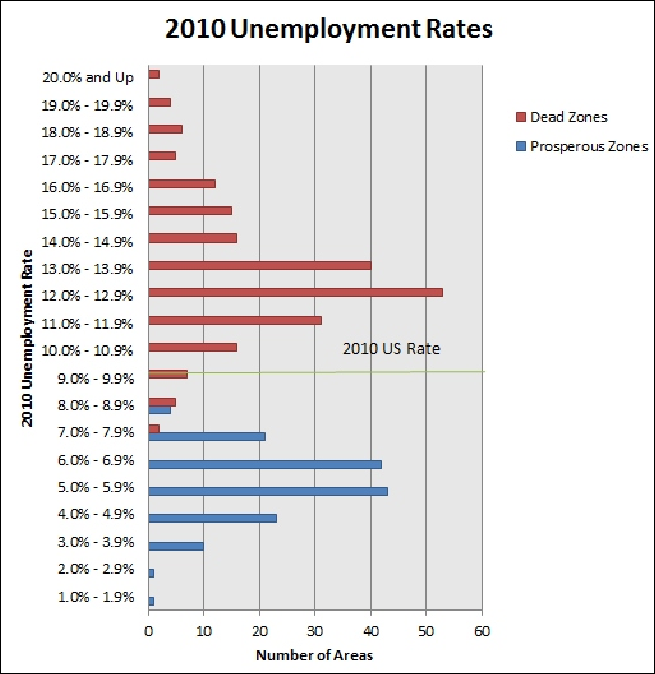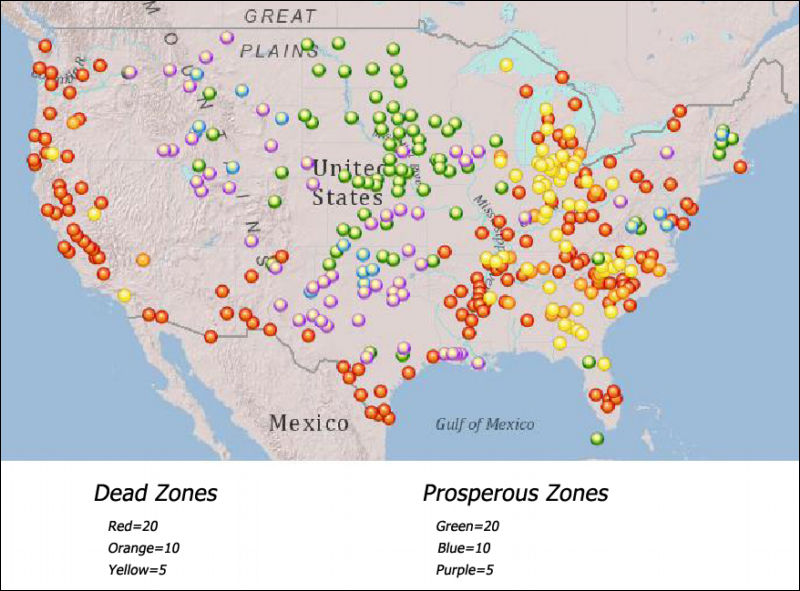
It allows to keep PV going, with more focus towards AI, but keeping be one of the few truly independent places.
-
There are 216 defined metropolitan (metro) and micropolitan (micro) areas—with populations ranging from 10,000 to 4 million—that have had unemployment rates at least two percentage points higher than the national average for either 20, 10, or 5 years (see tables 1, 2, 3 at the end of this article). These are America’s dead zones. Here employment growth is stagnant or non-existent and high levels of joblessness dominate. Some areas were once prosperous while others have recently experienced economic distress. In these communities paid work is hard to find for those who have not given up looking, and widespread involuntary idleness is the norm.
The wide variation in rates of unemployment between prosperous and dead zones is displayed below (click on the image to enlarge):

The map below presents a visual representation of dead and prosperous zonesIt shows, for example, that dead zones have existed in the South dating as far back as two decades. Furthermore, the last five years of data show almost no development of prosperous areas. The unevenness of the current national recovery is starker in dead zones, where unemployment rates have been high for longer periods of time.

Read the rest at: http://www.alternet.org/economy/153875/america’s_dead_zones%3A_from_detroit_to_dyersburg%2C_why_does_prosperity_pass_so_many_places_by/?page=entire

 us_unempl.png655 x 674 - 120K
us_unempl.png655 x 674 - 120K
 us_unempl2.jpg800 x 591 - 100K
us_unempl2.jpg800 x 591 - 100K
Howdy, Stranger!
It looks like you're new here. If you want to get involved, click one of these buttons!
Categories
- Topics List23,992
- Blog5,725
- General and News1,354
- Hacks and Patches1,153
- ↳ Top Settings33
- ↳ Beginners256
- ↳ Archives402
- ↳ Hacks News and Development56
- Cameras2,367
- ↳ Panasonic995
- ↳ Canon118
- ↳ Sony156
- ↳ Nikon96
- ↳ Pentax and Samsung70
- ↳ Olympus and Fujifilm101
- ↳ Compacts and Camcorders300
- ↳ Smartphones for video97
- ↳ Pro Video Cameras191
- ↳ BlackMagic and other raw cameras116
- Skill1,960
- ↳ Business and distribution66
- ↳ Preparation, scripts and legal38
- ↳ Art149
- ↳ Import, Convert, Exporting291
- ↳ Editors191
- ↳ Effects and stunts115
- ↳ Color grading197
- ↳ Sound and Music280
- ↳ Lighting96
- ↳ Software and storage tips266
- Gear5,420
- ↳ Filters, Adapters, Matte boxes344
- ↳ Lenses1,582
- ↳ Follow focus and gears93
- ↳ Sound499
- ↳ Lighting gear314
- ↳ Camera movement230
- ↳ Gimbals and copters302
- ↳ Rigs and related stuff273
- ↳ Power solutions83
- ↳ Monitors and viewfinders340
- ↳ Tripods and fluid heads139
- ↳ Storage286
- ↳ Computers and studio gear560
- ↳ VR and 3D248
- Showcase1,859
- Marketplace2,834
- Offtopic1,320
Tags in Topic
- economics 319




